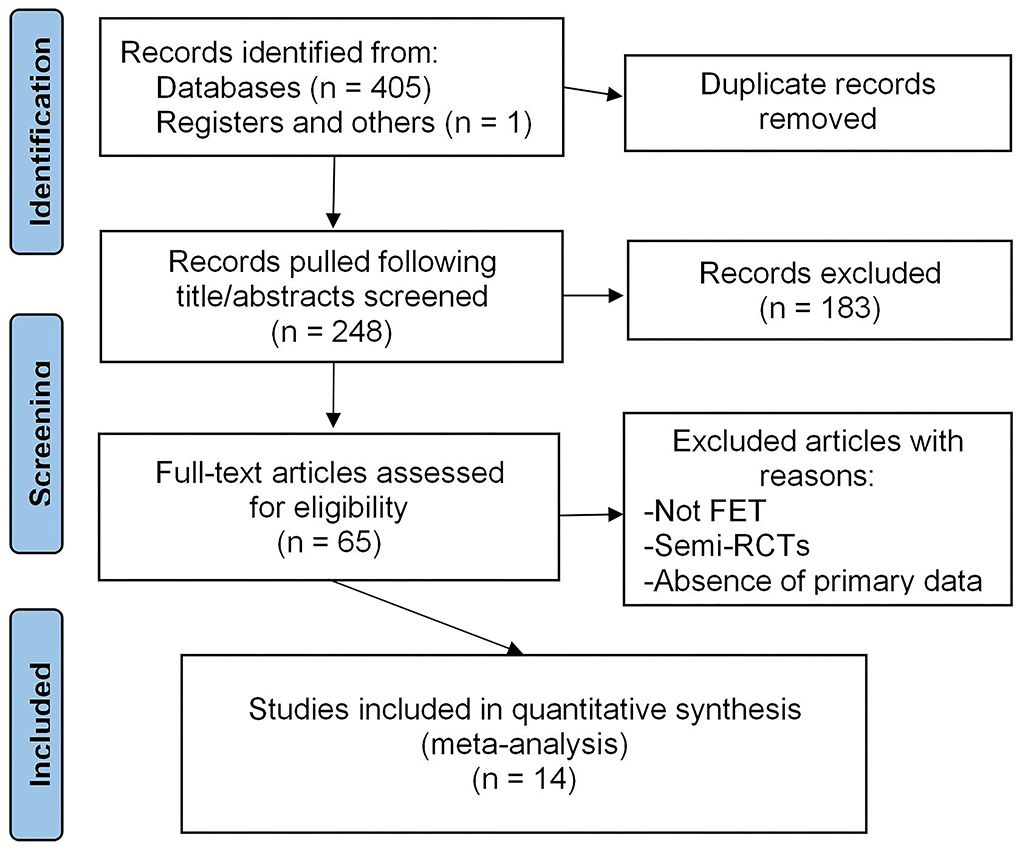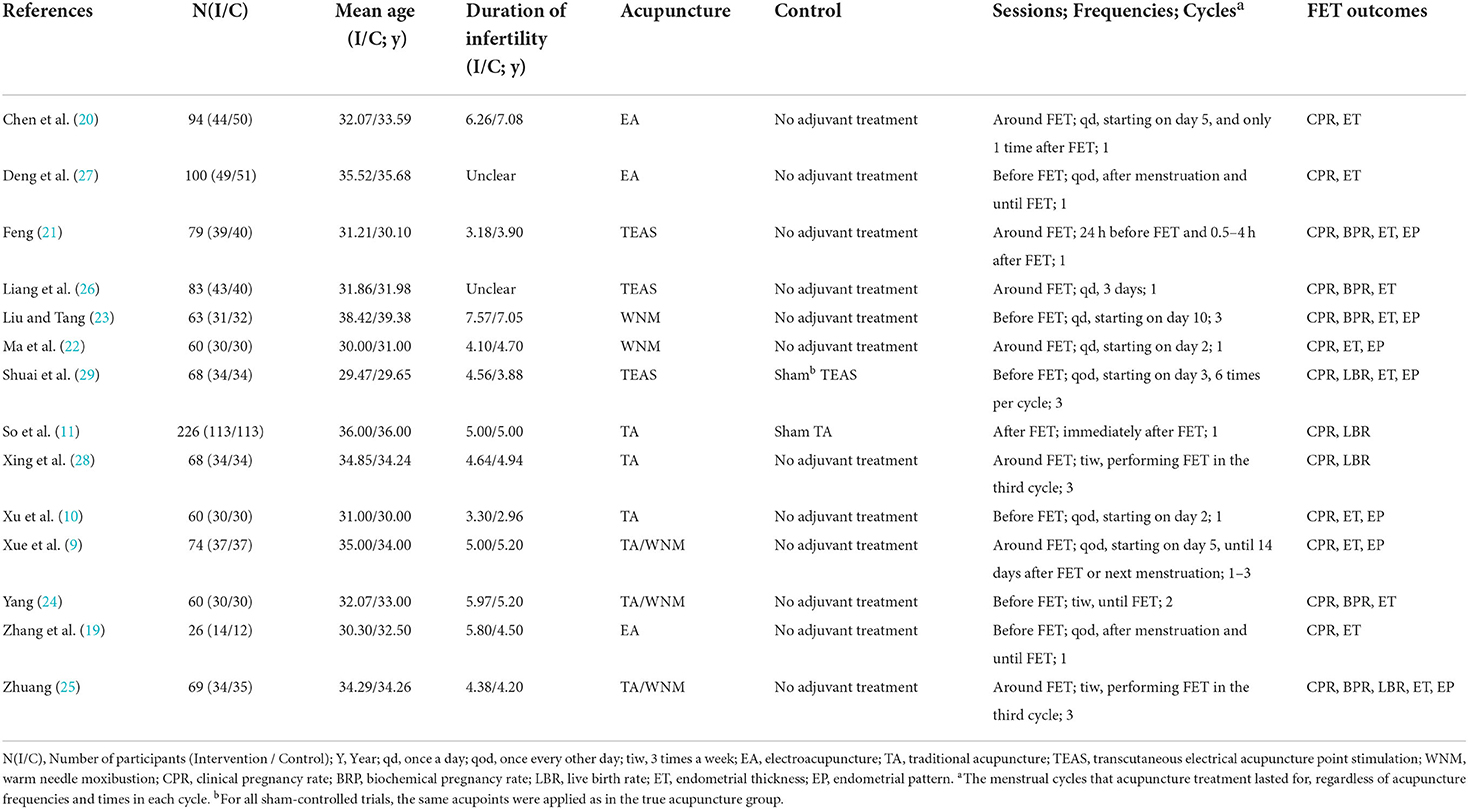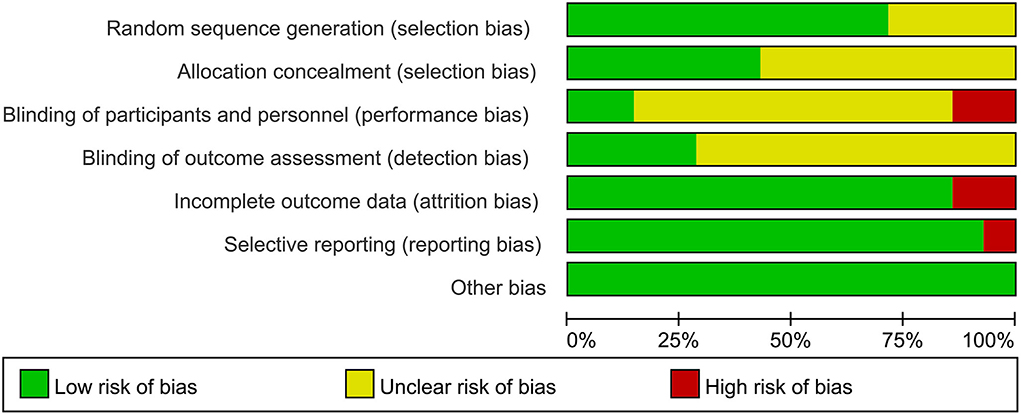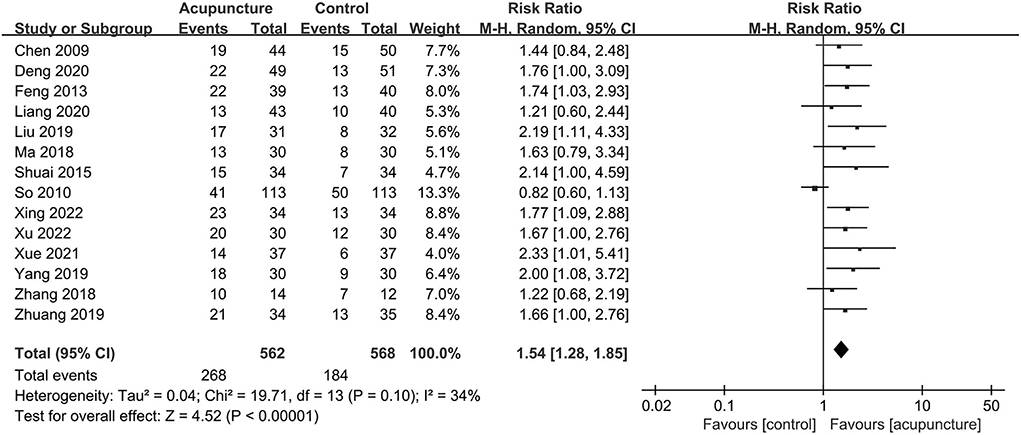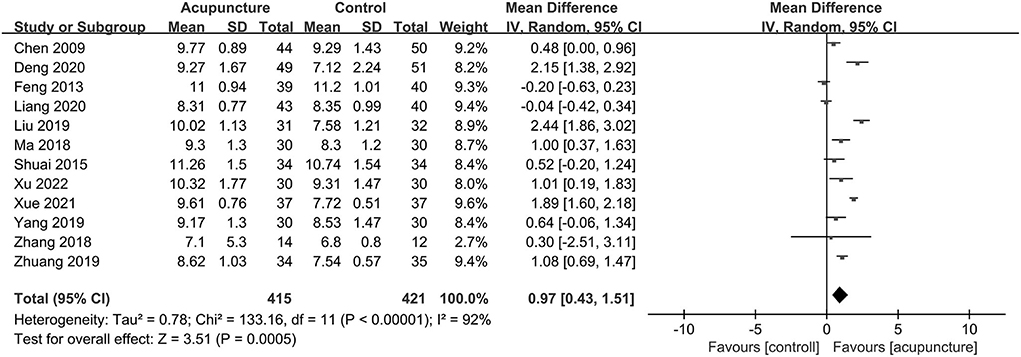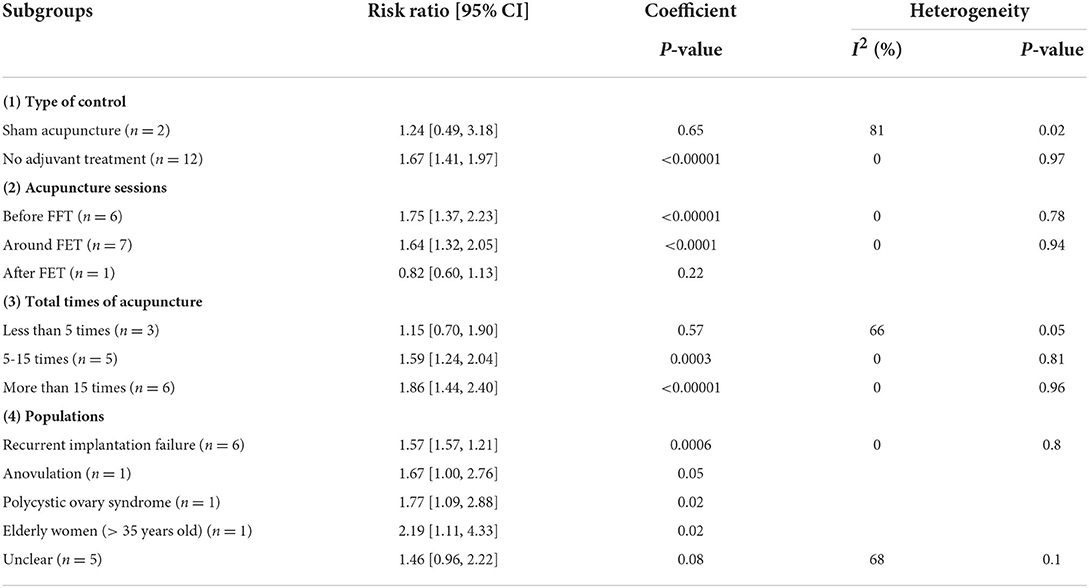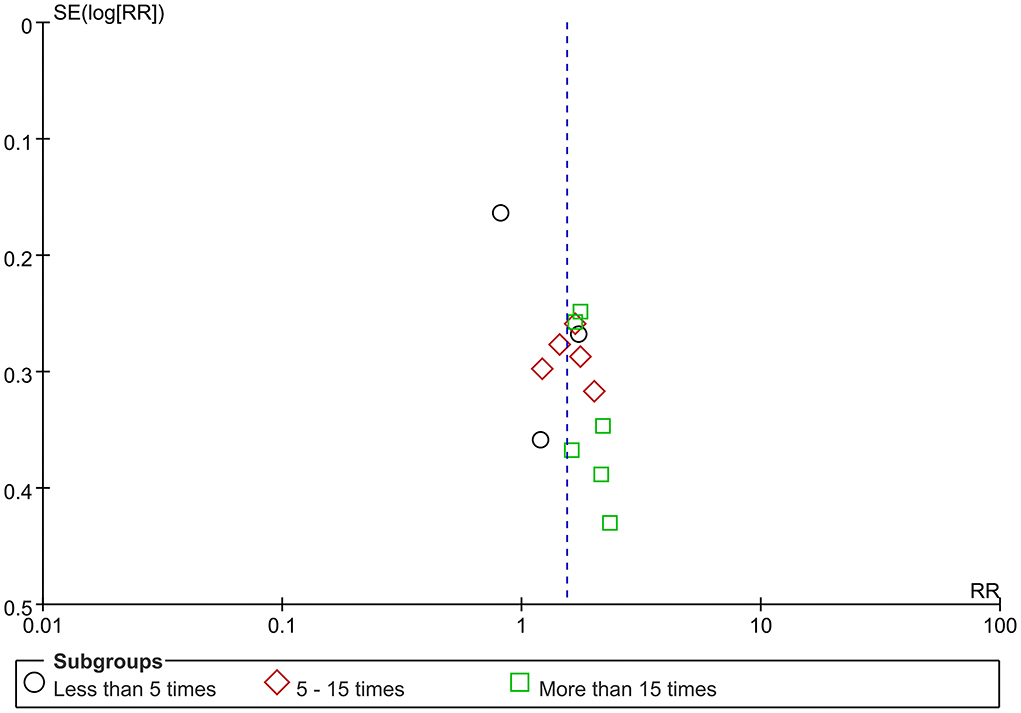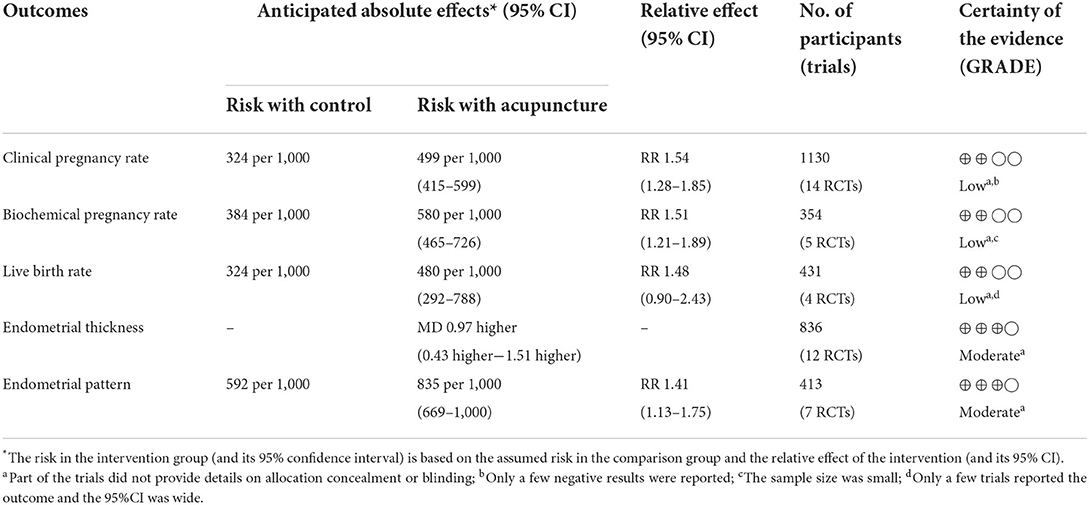- 1Department of Gynecology, Hospital of Chengdu University of Traditional Chinese Medicine, Chengdu, China
- 2School of Basic Medical Sciences, Guizhou University of Traditional Chinese Medicine, Guiyang, China
- 3School of Nursing, Chengdu University of Traditional Chinese Medicine, Chengdu, China
Background: Acupuncture is increasingly used as adjuvant therapy for infertile women undergoing frozen-thawed embryo transfer (FET); however, its effects and safety are highly controversial. This study aimed to evaluate the pooled effects of adjuvant acupuncture on FET pregnancy outcomes.
Methods: We considered only randomized controlled trials (RCTs) that compared acupuncture with sham acupuncture or no adjuvant treatment during FET and the primary outcome was clinical pregnancy rate. Two authors separately selected studies, extracted data, and performed a risk of bias assessment. Pooled data were expressed as risk ratio (RR) or mean difference (MD), with a 95% confidence interval (CI). In addition, we conducted subgroup and sensitivity analyses to investigate the sources of heterogeneity, and we also constructed funnel plots to assess the likelihood of publication bias. Finally, Grading of Recommendation, Assessment, Development, and Evaluation (GRADE) was applied to evaluate the quality of evidence.
Results: A total of 14 RCTs with a total of 1,130 participants were included in the study. We found significant effects of acupuncture adjuvant to FET on the outcomes of clinical pregnancy rate (RR = 1.54, 95% CI [1.28, 1.85], I2 = 34%; 14 trials), biochemical pregnancy rate (RR = 1.51, 95% CI [1.21, 1.89]; 5 trials), endometrial thickness (MD = 0.97, 95% CI [0.43, 1.51]; 12 trials), and endometrial pattern (RR = 1.41, 95% CI [1.13, 1.75]; 7 trials). For live birth rate (RR = 1.48, 95% CI [0.90, 2.43], 4 trials), there were no statistical effectiveness. For subgroup analyses, most variables had tolerable heterogeneity (I2 = 0%) except for trials that were sham-controlled, performed acupuncture only after FET, or <5 times, which appeared to interpret most of the heterogeneity. Additionally, the quality of evidence of all outcomes in this review ranged from low to moderate.
Conclusion: Acupuncture could be instrumental in the pregnancy outcomes of FET, and has very few risks of severe adverse events; however, the quality of evidence is unsatisfactory. Further research with rigorous methodological quality should be considered, and the protocols of acupuncture also need more investigations (e.g., appropriate control groups, sessions, and times).
Introduction
Infertility has become commonplace in recent years, with average morbidity of 8–12% worldwide (1) and 25% in China (2), resulting in severe influences on countless families and public health. Frozen-thawed embryo transfer (FET), as a crucial part of the assisted reproductive technique, is frequently performed for infertile women, especially when they suffer from cycle cancellation or implantation failure in previous embryo transfer cycles and have at least one eligible frozen embryo (3). Increasing evidence has shown that FET significantly decreases the risk of ovarian hyperstimulation syndrome (4), and frozen single blastocyst transfer has a higher live birth rate than does fresh cycle in ovulatory women (5). Nevertheless, despite advances in reproductive techniques, the clinical pregnancy rate of FET remains low, at only 58.7% (6).
Therefore, investigating adjuvant therapies to improve the outcomes of FET is of primary importance. Acupuncture is a vital portion of Traditional Chinese Medicine and is increasingly used as an adjuvant treatment for FET (7). Accumulating studies suggest that acupuncture can regulate the neuroendocrine immune system (8), improve endometrial receptivity, and reduce adverse reactions during FET (9, 10), thereby achieving better therapeutic effects. However, other randomized controlled trials (RCTs) hold distinct points, which find no significant benefits of acupuncture adjuvant to embryo transfer and the mechanism of its effects cannot be converged (11, 12).
To date, the effects and safety of acupuncture on pregnancy outcomes of FET are under controversy in clinical practice (13); however, relevant studies have placed more emphasis on fresh embryo transfer rather than FET (14, 15). Moreover, the systematic review and meta-analysis on acupuncture auxiliary to FET have not previously been reported. Therefore, we purpose to evaluate the effects and safety of acupuncture as an adjuvant treatment for infertile women undergoing FET, thus providing more evidence for further clinical practice and even experimental design.
Methods
This systematic review and meta-analysis followed the Preferred Reporting Items for Systematic Reviews and meta-analysis (PRISMA) statement (16) (Supplementary Presentation 1) and was registered in the International Platform of Registered Systematic Review and Meta-analysis Protocols (registration number: INPLASY2021110077; Supplementary Presentation 2).
Identification of studies
We searched for RCTs in electronic databases, such as Cochrane Library, PubMed, Embase, and the Chinese Biomedical database (SinoMed), Chinese National Knowledge Infrastructure (CNKI), and Chinese Technology Periodical Database (VIP), from inception to 30 June 2022. We also searched for previous systematic reviews on acupuncture for embryo transfer in order to review trials related to FET. In addition, the following databases of ongoing trials are retrieved: Clinicaltrials.gov, the World Health Organization's International Clinical Trials Registry Platform, and the Chinese Clinical Trial Register. We combined MeSH terms and free words in retrieval, and the search strategy of PubMed is shown in Supplementary Table 1, which is parallel to other databases.
Inclusion criteria
We considered only RCTs that compared acupuncture with sham acupuncture or no adjuvant treatment for infertile women undergoing FET, with the objective to improve FET success rates. There were no restrictions on the reasons for FET and the protocols of FET. And trials that considered in vitro fertilization or intracytoplasmic sperm injection as fertilization protocols before FET were eligible. We included acupuncture performed at any time around FET (i.e., before, around, and after FET), and all types of acupuncture were considered (e.g., traditional acupuncture, electroacupuncture, and transcutaneous electrical acupuncture point stimulation). We also identified any unpublished trials that met our inclusion criteria. In addition, we included RCTs published in any language.
Exclusion criteria
We excluded trials that assessed acupuncture as an adjuvant therapy to anesthesia for oocyte retrieval, because the purpose, protocol, and administration of these two sets of trials were far removed from each other. Besides, trials that offered insufficient and unreliable information on their methods and outcomes were excluded. We also excluded patients who were treated with co-intervention of acupuncture and herbal medicine, because it resulted in unequal co-intervention across treatment groups.
Outcome measures
We pre-specified clinical pregnancy rate (CPR) as our primary outcome, because it was reported in more RCTs and would contribute to our major analyses. The definition of CPR was the presence of at least one gestational sac with a fetal heartbeat, which was confirmed by ultrasound 5 weeks after transfer (6). The secondary outcomes were optional: biochemical pregnancy rate, a positive hCG serum, or urine test 14 days after transfer; live birth rate, any neonate born alive after 28 weeks gestation; endometrial thickness; and endometrial pattern, regarding the triple-line pattern (Pattern A and B) as the most suitable for fertility (17).
Data extraction
Two authors (CZ and WX) independently extracted data, with disagreements discussed and resolved with the corresponding author (QZ). The full texts of the studies would be screened for further evaluation if the titles and abstracts were eligible. We extracted characteristics of included studies with a standardized data extraction form, such as the methods, participants, interventions, control groups, outcomes, and adverse events. We contacted the corresponding authors of those trials that afforded insufficient details on their articles to obtain further information.
Risk of bias assessment
The Cochrane risk of bias assessment tool was used to evaluate the methodological quality of included trials. The criteria were composed of the following domains: random sequence generation (selection bias), allocation concealment (selection bias), blinding of participants and personnel (performance bias), incomplete outcome data (attrition bias), selective reporting (reporting bias), and other bias. Two authors (CZ and WX) separately assessed each item as high, low, or unclear risk of bias. Any disagreements were resolved by discussion with the corresponding author (QZ) and methodological experts. Due to the particularity of acupuncture, blinding patients and physicians was difficult and the absence of blinding them was not considered a critical source of bias.
Data synthesis and analysis
We used Review Manager 5.4 to calculate the pooled data. The outcome measures were expressed with risk ratio (RR) when acted as dichotomous data or mean difference (MD) when performed as continuous data, and a 95% confidence interval (CI). And the statistical heterogeneity between included studies was evaluated by using both the I2 statistic and the P-value of the χ2 test. According to the Cochrane Handbook (18), the following guides are suggested for interpreting I2 values: 0–40% might not be important; 30–60% may represent moderate heterogeneity; 50–90% may represent substantial heterogeneity; and 75–100% may represent considerable heterogeneity. Whether a fixed-effects model or a random-effects model was applied depends on the comprehensive analyses of statistical, clinical, and methodological heterogeneity. For our meta-analysis, if the statistical heterogeneity was moderate or above (I2 > 30%) by using the fixed-effects model, we would investigate the sources of heterogeneity through subgroup or sensibility analyses for the primary outcome and turn to the random-effects model, because the clinical heterogeneity of acupuncture protocols and settings was expected. After that, if the heterogeneity could not be explained, this review would be reported as a description of the included studies instead of data synthesis. When at least 10 studies were included, we would construct funnel plots to assess the likelihood of publication bias.
Subgroup and sensitivity analyses
We performed subgroup analyses that might contribute to heterogeneity and impact the effects of adjuvant acupuncture on the primary outcome. (1) Type of control: Sham acupuncture or no adjuvant treatment. (2) Acupuncture sessions: Before, around, or after FET. (3) Total times of acupuncture: Less than 5 times, 5–15 times, or more than 15 times. (4) Populations: Recurrent implantation failure, anovulation, polycystic ovary syndrome, elder women (>35 years old), and unclear. We also conducted a sensitivity analysis using the leave-one-out approach: Excluding the trials which were potential contributors to heterogeneity and instability, the primary outcome would be analyzed again.
Quality of evidence
The quality of evidence of every outcome was evaluated by the Grading of Recommendation, Assessment, Development, and Evaluation (GRADE) approach, and was classified into four levels: very low, low, moderate, or high. We used the GRADE pro-GDT to perform it by assessing the following five items: study design, risk of bias, inconsistency, indirectness, imprecision, and other considerations.
Results
Study selection
Figure 1 shows the process of study selection. With screening titles and abstracts, 183 studies were excluded because of animal experiments, reviews, comments, case reports, study protocols, non-RCTs, combination with other interventions, etc. Then, further 51 trials were excluded after full-text trials assessed for eligibility: 47 trials focused on fresh embryo transfer or mixture with fresh and frozen-thawed embryo transfer; 1 trial lacked essential data; 3 trials were semi-RCTs grouped with considering patients' selection or the order of visiting doctors. Finally, 14 RCTs with a total of 1,130 participants were included.
Trial characteristics
The main characteristics of included trials are presented in Table 1. Despite no restrictions on the country, all 14 trials were performed in China. In all trials, women received acupuncture as an adjuvant treatment for FET. And the protocols and settings of acupuncture, which retained 25–30 min every time and lasted for 1–3 menstrual cycles, were designed for the sole objective of improving pregnancy outcomes. In terms of control types, 12 trials conducted no adjuvant treatment control (9, 10, 19–28), whereas the other 2 trials used sham acupuncture control (11, 29). Moreover, 3 trials applied electroacupuncture (19, 20, 27), 2 trials adopted warm needle moxibustion (22, 23), 3 trials employed transcutaneous electrical acupoint stimulation (21, 26, 29), 3 trials used traditional acupuncture (10, 11, 28), and the remaining 3 trials contained traditional acupuncture and warm needle moxibustion (9, 24, 25). Furthermore, 10 trials reported the DeQi sensation (9–11, 19, 20, 22, 24, 25, 27, 28), which referred to a soreness, numbness, or distension around the puncture sites or sometimes propagation along the corresponding meridians and indicated the correct needle insertion, whereas other 4 trials did not report DeQi sensation (21, 23, 26, 29), and 3 of them applied TEAS without needle insertion. Of all the trials, one was a three-arm trial (19) and the other was a four-arm trial (26), and we only extracted groups that met our inclusion criteria. For all the trials, baseline characteristics were reported as comparable between the randomized groups.
Methodological quality of included trials
Figure 2 demonstrates the assessment for the risk of bias. For 10 trials (9–11, 19, 22, 24–26, 28, 29), adequate information about random sequence generation was reported. For the other 4 trials (20, 21, 23, 27), the details of the random sequence were not available, and we assessed them as unclear risk of selection bias; however, the randomization seemed to be successful because of no baseline differences between groups. A total of 8 of all trials did not provide adequate allocation concealment, but there was also baseline resemblance between the compared groups (19–23 and 26–28). Due to the particularity of acupuncture, blinding patients and physicians was difficult, therefore only two trials (11, 29) performed blinding of patients resulting in a low risk of performance bias, another two trials (24, 25) clearly reported no blinding, and the rest 10 trials (9, 10, 19–23, 26–28) did not mention whether blinding was adopted or not. In 4 trials (9, 11, 24, 25), blinding of outcome assessment was applied, whereas the other 10 trials (10, 19–23, 26–29) had no sufficient information about it. For incomplete outcome data, 12 trials (9–11, 20–25, 27–29) had no attrition bias for missing patients or data; however, 2 trials (19, 26) did not report why it appeared the unequal numbers of patients when randomly grouped (intervention/control = 14/12 and 43/40, respectively).
Efficacy analyses
The clinical pregnancy rate, which was considered the primary outcome in our study and was reported in all included trials, had significant pooled benefits of acupuncture adjuvant to FET with statistically moderate heterogeneity (RR = 1.54, 95% CI [1.28, 1.85], P < 0.00001; I2 = 34%; Figure 3). For biochemical pregnancy rate involved in five trials (21, 23–26), we also found significant effects of acupuncture and the heterogeneity might not be important (RR = 1.51, 95% CI [1.21, 1.89], P = 0.0002; I2 = 0; Figure 4). However, for live birth rate, which were reported in four trials (11, 25, 28, 29), there was no statistical difference between the two groups, and the heterogeneity was substantial (RR = 1.48, 95% CI [0.90, 2.43], P = 0.012; I2 = 72; Figure 5).
In addition, the endometrial thickness reported in 12 trials (9, 10, 19–27, 29) was statistically increased, and the heterogeneity was substantial (MD = 0.97, 95% CI [0.43, 1.51], P = 0.0005; I2 = 92%; Figure 6). Besides, seven trials (9, 10, 21–23, 25, 29) measured endometrial pattern, and we found the acupuncture could significantly promote the number of trilinear endometrium (Patterns A and B) with substantial heterogeneity (RR = 1.41, 95% CI [1.13, 1.75], P = 0.002; I2 = 73%; Figure 7).
Sources of heterogeneity
To investigate the sources of heterogeneity, we combined all 14 trials for subgroup analyses on the primary outcome (clinical pregnancy rate), and the variables that might impact the effects of adjuvant acupuncture on FET were evaluated. The analyses showed that sham-controlled trials and trials of performing acupuncture <5 times had substantial heterogeneity (I2 = 81 and 66%, respectively). Moreover, the above two variables, the trials of conducting acupuncture only after FET, and the trials of not mentioning a specific population (unclear) indicated no significant effects (P = 0.65, 0.22, 0.57, and 0.08; respectively; Table 2; Supplementary Figures 1–4).
We also carried out a sensitivity analysis to further interpret the heterogeneity and detect instability. When we excluded the So (2010) trial (11), the statistical heterogeneity decreased to be not important (I2 = 0%), and the pooled benefits were stable (RR = 1.69, 95% CI [1.43, 1.99]; Supplementary Figure 5).
Publication bias
The funnel plot (Figure 8) including all 14 trials on clinical pregnancy rate was asymmetric.
Adverse events
A total of four trials (11, 19, 24, 25) reported adverse events, such as nausea or dizziness, but none of these trials mentioned any serious adverse events associated with acupuncture and hindered subsequent treatment.
Certainty of evidence
By using the GRADE pro-GDT, the evidence of clinical pregnancy rate was low certainty, indicating our confidence in the effect estimate was limited. For other outcomes, the level of evidence ranged from low to moderate, and more details were available in Table 3.
Discussion
The past few years have seen acupuncture as an adjuvant therapy to FET for infertile women become a hot-button issue that has sparked numerous studies in the reproductive field. However, the effects and safety of acupuncture on the outcomes of FET are highly controversial (12, 13).
Main findings
Obtaining pregnancy is the ultimate objective of acupuncture auxiliary to FET. Moreover, a moderate endometrial thickness (between 7 and 14 mm) with the triple-line pattern (Pattern A and B) also contributes directly to embryo implantation, thus improving pregnancy outcomes (17).
In the study, we found significant pooled effects of acupuncture adjuvant to FET on the clinical pregnancy rate and biochemical pregnancy rate, suggesting that acupuncture treatment could improve the FET success rates. Acupuncture might act on the hypothalamic–pituitary–ovarian axis and target the uterus (30), up-regulate the IRS-1/PI3K/GLUT4 signaling pathway to promote embryonic development potential in patients with PCOS-IR (31), alleviate Shen deficiency syndrome, and increase the clinical pregnancy during embryo transfer (32). Besides, it was observed that three sessions of acupuncture around embryo transfer significantly improved pregnancy outcomes and reduced anxiety levels in women with unexplained infertility (33).
Furthermore, our study showed that acupuncture was also significantly beneficial in the endometrial thickness and triple-line pattern during FET, indicating that this therapy could improve endometrium receptivity, thus increasing pregnancy rates. It was predicted that hsa-miR-449a, hsa-miR-3135b, and hsa-miR-345-3p might be associated with the mechanisms that acupuncture contributed to endometrium receptivity to prepare for embryo transfer (34); and reviews also reported that acupuncture had effects on endometrial receptivity and pregnancy outcomes of recurrent implantation failure (35, 36).
In addition, although acupuncture had no statistical effects on the live birth rate of FET, it also showed an increasing trend. This might be tied up with the fact that only four included trials reported the outcome, and the sample size was too small to obtain accurate effects.
Heterogeneity analyses
Most of our outcomes were accompanied by moderate or substantial heterogeneity. Therefore, we performed subgroup analyses to explore the sources of heterogeneity, combining all 14 trials on the primary outcome. The analyses showed most variables served as significant catalysts for the effectiveness of acupuncture except for four variables, which were sham-controlled and performed acupuncture only after FET or <5 times, and had an unclear population.
According to related studies (37–39), the sham-controlled trials had a risk that sham acupuncture might have acupuncture-specific effects on pregnancy outcomes via the identical mechanism of true acupuncture, especially when sham needles were placed at the true acupuncture points, suggesting that the sham acupuncture was not an inert control and the effects of true acupuncture might be underestimated, as was the case in the two sham-controlled trials (11, 29) included in our study. Besides, as was mentioned before, acupuncture could improve endometrial morphology and thereby increase pregnancy rates, while the subgroup that performed needles only after FET might have fewer efficacies on pregnancy outcomes than other variables, as was the case in the trial (11) included in this review. Moreover, there was no significant effect in the subgroup of conducting acupuncture <5 times, which might imply that fewer acupuncture times had insufficient efficacy on pregnancy outcomes of FET. Finally, it showed no statistical effect in the subgroup of the unclear population, which might result from therapeutic protocols and doctor–patient interactions, and so on (40). Nevertheless, we found acupuncture adjuvant to FET could be significantly beneficial to the populations such as recurrent implantation failure, polycystic ovary syndrome, and elderly women.
These above-mentioned four variables were involved in the same trial (11) and might be the source of heterogeneity. So, we removed it for a sensitivity analysis and then found the statistical heterogeneity reduced to be not important and the pooled benefit of acupuncture on the primary outcome was stable, which might further interpret most of the heterogeneity in the results.
Publication bias
The funnel plot on clinical pregnancy rate showed asymmetrically, which might indicate publication bias. Generally, the asymmetric resulted from more effects in smaller trials, and positive results were easier to be published. Besides, language and regional bias could also invite it; of all included trials, two were published in English (11, 29) and others in Chinese (9, 10, 19–28), and all trials were conducted in China. Moreover, clinical heterogeneity such as different acupuncture protocols between trials was also a potential contributor to asymmetry. Finally, although we attempted to gain any unpublished or unidentified trials with negative results, none were located, which was possibly responsible for the funnel plot asymmetry as well (38).
Safety of acupuncture
Acupuncture is a mild treatment with relatively fewer adverse reactions and costs. Of all included trials, only four reported adverse events such as nausea or dizziness, and it could be concluded that adverse events associated with acupuncture were extremely limited and no serious reactions were reported. Although acupuncture has very few risks of severe adverse events, physicians can prevent most adverse reactions through specialized knowledge and administration. And the expert consensus (41) also suggested that electroacupuncture or transcutaneous electrical acupuncture point stimulation (TEAS) combined with assisted reproductive technique might be regarded as a model of the integrated application of traditional Chinese medicine and modern medicine; in particular, TEAS is widely favored by patients owing to its advantages of easy-operation, non-invasive nature, and painless procedures.
Quality of evidence
The quality of evidence of all outcomes ranged from low to moderate. According to the GRADE Working Group (https://www.gradepro.org/), low certainty indicates the true effect may be substantially different from the estimate of the effect; and moderate certainty suggests the true effect is likely to be close to the estimate of the effect, but there is a possibility that it is substantially different. In our study, the reasons for the downgrades of evidence level mainly contained the following two: Part of the trials did not provide details on allocation concealment or blinding, and only a few negative results were reported. In fact, due to the particularity of acupuncture, blinding patients and physicians was difficult, which should not be considered as a critical source of bias (24). Although the results showed significant pooled benefits of acupuncture in comparison to the control group, eligible clinical trials with high methodological quality are needed to improve the level of evidence.
Limitations
The following two are taken as the major limitations in our study: The quality of included trials and reporting bias. First, part of included trials have insufficient information about random sequence generation, allocation concealment, or blinding of outcome assessment, and have shown small sample sizes, which result in low methodological quality and, therefore, downgrade the evidence level. Furthermore, some types of reporting bias cannot be excluded in this review, such as publication bias, language, and regional bias, which can potentially invite limitations, and thereby it is difficult to obtain accurate results.
Conclusion
Acupuncture could be instrumental in the pregnancy outcomes of FET, and the quality of evidence ranges from low to moderate. Nowadays, acupuncture has been undertaken widely in China and other nations, and has very few risks of severe adverse events. However, trials with small sample sizes and low methodological quality lead to uncertain findings. Therefore, for future studies, RCTs with rigorous methodological quality on a large scale should be considered, and the protocols of acupuncture also need more investigations (e.g., appropriate control groups, sessions, and times). In addition, when performing acupuncture as an adjuvant treatment for in vitro fertilization– embryo transfer, the differences between FET and fresh cycles deserve further research.
Data availability statement
The original contributions presented in the study are included in the article/Supplementary material, further inquiries can be directed to the corresponding author.
Author contributions
CZ and WX designed the study, conducted this analysis, and wrote and edited the manuscript. JH and XZ participated in selecting articles and performing the quality assessment. FL, XY, and JM helped to search the literature and analyzed the data. QZ proposed the study, explained the data, and revised the report. All authors provided comments on the manuscript and approved its final version.
Funding
This study was supported by the Sichuan Province's Science and Technology Project Fund of China (No. 2020YFSY0043) and the National Natural Science Foundation of China (Nos. 82174430 and 81973901).
Conflict of interest
The authors declare that the research was conducted in the absence of any commercial or financial relationships that could be construed as a potential conflict of interest.
Publisher's note
All claims expressed in this article are solely those of the authors and do not necessarily represent those of their affiliated organizations, or those of the publisher, the editors and the reviewers. Any product that may be evaluated in this article, or claim that may be made by its manufacturer, is not guaranteed or endorsed by the publisher.
Supplementary material
The Supplementary Material for this article can be found online at: https://www.frontiersin.org/articles/10.3389/fpubh.2022.987276/full#supplementary-material
References
1. Vander Borght M, Wyns C. Fertility and infertility: definition and epidemiology. Clin Biochem. (2018) 62:2–10. doi: 10.1016/j.clinbiochem.2018.03.012
2. Zhou Z, Zheng D, Wu H, Li R, Xu S, Kang Y, et al. Epidemiology of infertility in China: a population-based study. BJOG. (2018) 125:432–41. doi: 10.1111/1471-0528.14966
3. Shi YH, Wang QM, Qi D. Frontier research hotspot and progress in assisted reproductive technology. J Shandong Univ. (2021) 59:97–102. doi: 10.6040/j.issn.1671-7554.0.2021.0826
4. Roque M, Haahr T, Geber S, Esteves SC, Humaidan P. Fresh versus elective frozen embryo transfer in IVF/ICSI cycles: a systematic review and meta-analysis of reproductive outcomes. Hum Reprod Update. (2019) 25:2–14. doi: 10.1093/humupd/dmy033
5. Wei D, Liu JY, Sun Y, Shi Y, Zhang B, Liu JQ, et al. Frozen versus fresh single blastocyst transfer in ovulatory women: a multicentre, randomised controlled trial. Lancet. (2019) 393:1310–8. doi: 10.1016/S0140-6736(18)32843-5
6. Pan Y, Li B, Wang Z, Wang Y, Gong X, Zhou W, et al. Hormone replacement versus natural cycle protocols of endometrial preparation for frozen embryo transfer. Front Endocrinol. (2020) 11:546532. doi: 10.3389/fendo.2020.546532
7. Wang YR. The effect of acupuncture at different time points on the pregnancy rate of frozen-thawed embryo transfer (Doctor's thesis). Beijing University of Chinese Medicine (China) (2021)
8. Li NC, Li MY, Chen B, Guo Y. A new perspective of acupuncture: the interaction among three networks leads to neutralization. Evid Based Complement Alternat Med. (2019) 2019:2326867. doi: 10.1155/2019/2326867
9. Xue HM, Li YM, Chen YT, Li C, Zhang Y, Jin P, et al. Effect of staging treatment of Tongyuan acupuncture on pregnancy outcome in patients with recurrent implantation failure of thin endometrium type. Chin Acupunct Moxibustion. (2021) 41:1338–42. doi: 10.13703/j.0255-2930.20210105-k0001
10. Xu LL, Zhou X, Zhang CR, Zhang JB. Effect of acupuncture on pregnancy outcomes of frozen embryo transfer in patients with anovulatory infertility. Chin Acupunct Moxibustion. (2022) 42:150–4. doi: 10.13703/j.0255-2930.20210206-0002
11. So EW, Ng EH, Wong YY, Yeung WS, Ho PC. Acupuncture for frozen-thawed embryo transfer cycles: a double-blind randomized controlled trial. Reprod Biomed Online. (2010) 20:814–21. doi: 10.1016/j.rbmo.2010.02.024
12. Smith CA, de Lacey S, Chapman M, Ratcliffe J, Norman RJ, Johnson NP, et al. Effect of acupuncture vs sham acupuncture on live births among women undergoing in vitro fertilization: a randomized clinical trial. JAMA. (2018) 319:1990–8. doi: 10.1001/jama.2018.5336
13. Wang YN, Zhao HY, Yu Sy, Hu YP. Consideration and analysis on “Effect of acupuncture vs sham acupuncture on live births among women undergoing in vitro fertilization: a randomized clinical trial. JAMA Chin Acupunct Moxibustion. (2019) 39:787–91. doi: 10.13703/j.0255-2930.2019.07.028
14. Wang X, Wang Y, Wei S, He B, Cao Y, Zhang N, et al. An overview of systematic reviews of acupuncture for infertile women undergoing in vitro fertilization and embryo transfer. Front Public Health. (2021) 9:651811. doi: 10.3389/fpubh.2021.651811
15. Wu JM, Ning Y, Ye YY, Liu YL, Tang M, Hu S, et al. Effects of acupuncture on endometrium and pregnancy outcomes in patients with polycystic ovarian syndrome undergoing in vitro fertilization-embryo transfer: a randomized clinical trial. Chin J Integr Med. (2022) 28:736–42. doi: 10.1007/s11655-022-3498-z
16. Page MJ, McKenzie JE, Bossuyt PM, Boutron I, Hoffmann TC, Mulrow CD, et al. The PRISMA 2020 statement: an updated guideline for reporting systematic reviews. BMJ. (2021) 372:n71. doi: 10.1136/bmj.n71
17. Zhao J, Zhang Q, Li Y. The effect of endometrial thickness and pattern measured by ultrasonography on pregnancy outcomes during IVF-ET cycles. Reprod Biol Endocrinol. (2012) 10:100. doi: 10.1186/1477-7827-10-100
18. Cumpston M, Li T, Page MJ, Chandler J, Welch VA, Higgins JP, et al. Updated guidance for trusted systematic reviews: a new edition of the Cochrane Handbook for Systematic Reviews of Interventions. Cochrane Database Syst Rev. (2019) 10:Ed000142. doi: 10.1002/14651858.ED000142
19. Zhang LX, Lan RX, Zheng CY. Effect of pricking blood therapy on clinical outcomes of frozen-thawed embryo transfer cycles in patients with thin endometrium. J Reprod Med. (2018) 27:411–5. doi: 10.3969/j.issn.1004-3845.2018.05.004
20. Chen J, Zhao Y, Sun W. Effect of electro-acupuncture treatment on the patients undergoing the natural cycle of frozen embryo transfer. Chin J Hum Sex. (2009) 18:33–5.
21. Feng XH. The influence of transcutaneous electrical acupoint stimulation (TEAS) on endometrial receptivity in patients treated with frozen-thawed embryo transfer (FET) and the prelimina mechanism research (Master's thesis). Shandong University of Traditonal Chinese Medicine (China). (2013).
22. Ma JJ, Zhang QH, Weng XC Dai MC. Effect of warm needling on endometrial receptivity and pregnancy outcome in kidney-yang deficient patients with repeated implantation failure in IVF-ET. Shanghai J Acupunct Moxibustion. (2018) 37:1339–44. doi: 10.13460/j.issn.1005-0957.2018.12.1339
23. Liu YM, Tang JH. A randomized controlled study on the success rate of warm acupuncture on tube baby in elderly patients with kidney-yang deficiency and its effect on menstruation and endometrial level. World Chin Med. (2019) 14:1880–3. doi: 10.3969/j.issn.1673-7202.2019.07.056
24. Yang L. The clinical observation on pregnancy outcome of the women on FET with tranquilizing, smoothing liver and tonifying spleen acupuncture and moxibustion (Master's thesis>). Chengdu University of Traditional Chinese Medicine (China) (2019)
25. Zhuang HN. Clinical study on the improvement of endometrial recepbility of freeze-thaw embryo transfer cycle in rif patients with kidney deficiency and liver depression by staged acupuncture therapy based on the theory of “chong meridian is the sea of blood” (Master's thesis). Yunnan University of Chinese Medicine (China) (2019)
26. Liang Y, Li JJ, Liu M, He FE, Zhang JM, Peng DM. The effect of Traditional Chinese Medicine of tonifying kidney and promoting blood circulation combined with transcutaneous electrical acupoint stimulation on the pregnancy outcome of patients with repeated frozen-thawed embryo transfer failure. J Pract Obstet Gynecol. (2020) 36:550–2.
27. Deng C, Chen LF, Ma R, Wang Y, Chen YY, Zheng Q, et al. Clinical Observation of Electroacupuncture Therapy in Patients with Repeated Implantation Failure in IVF-ET. Mil Med J S Chin. (2020) 31:393–6. doi: 10.13730/j.issn.10092595.2020.06.006
28. Xing LW, Liu F, Dong QZ, Wu KN, He Z, Sun YH, et al. Efficacy observation of staged acupuncture and moxibustion therapy based on the theory of thorough fare vessel being sea of blood' on frozen-thawed embryo transfer in patients with polycystic ovary syndrome. CJTCMP. (2022) 37:2755–8.
29. Shuai ZH, Lian F, Li PF, Yang WX. Effect of transcutaneous electrical acupuncture point stimulation on endometrial receptivity in women undergoing frozen-thawed embryo transfer: a single-blind prospective randomised controlled trial. Acupunct Med. (2015) 33:9–15. doi: 10.1136/acupmed-2014-010572
30. Feng J, Wang J, Zhang Y, Zhang Y, Jia L, Zhang D, et al. The efficacy of complementary and alternative medicine in the treatment of female infertility. Evid Based Complement Alternat Med. (2021) 2021:6634309. doi: 10.1155/2021/6634309
31. Xiang S, Xia MF, Song JY, Liu DQ, Lian F. Effect of electro-acupuncture on expression of IRS-1/PI3K/GLUT4 pathway in ovarian granulosa cells of infertile patients with polycystic ovary syndrome-insulin resistance of phlegm-dampness syndrome. Chin J Integr Med. (2021) 27:330–5. doi: 10.1007/s11655-020-3219-z
32. Wu HC, Zhang JW, Sun ZG, Xiang S, Qiao Y, Lian F. Effects of electroacupuncture on expression of PI3K/Akt/Foxo3a in granulosa cells from women with shen (Kidney) deficiency syndrome undergoing in vitro fertilization-embryo transfer. Chin J Integr Med. (2019) 25:252–8. doi: 10.1007/s11655-019-2948-3
33. Guven PG, Cayir Y, Borekci B. Effectiveness of acupuncture on pregnancy success rates for women undergoing in vitro fertilization: a randomized controlled trial. Taiwan J Obstet Gynecol. (2020) 59:282–6. doi: 10.1016/j.tjog.2020.01.018
34. Mu Y, Li Q, Cheng J, Shen J, Jin X, Xie Z, et al. Integrated miRNA-seq analysis reveals the molecular mechanism underlying the effect of acupuncture on endometrial receptivity in patients undergoing fertilization: embryo transplantation. 3 Biotech. (2020) 10:6. doi: 10.1007/s13205-019-1990-3
35. Zhong Y, Zeng F, Liu W, Ma J, Guan Y, Song Y. Acupuncture in improving endometrial receptivity: a systematic review and meta-analysis. BMC Complement Altern Med. (2019) 19:61. doi: 10.1186/s12906-019-2472-1
36. Li M, Liu Y, Wang H, Zheng S, Deng Y, Li Y. The Effects of acupuncture on pregnancy outcomes of recurrent implantation failure: a systematic review and meta-analysis. Evid Based Complement Alternat Med. (2021) 2021:6661235. doi: 10.1155/2021/6661235
37. Zhou X, Li X, Ding H, Lu Y. Acupuncture effects on in-vitro fertilization pregnancy outcomes: a meta-analysis. Complement Ther Clin Pract. (2022) 46:101525. doi: 10.1016/j.ctcp.2021.101525
38. Manheimer E, van der Windt D, Cheng K, Stafford K, Liu J, Tierney J, et al. The effects of acupuncture on rates of clinical pregnancy among women undergoing in vitro fertilization: a systematic review and meta-analysis. Hum Reprod Update. (2013) 19:696–713. doi: 10.1093/humupd/dmt026
39. Coyle ME, Stupans I, Abdel-Nour K, Ali H, Kotlyarsky M, Lie P, et al. Acupuncture versus placebo acupuncture for in vitro fertilisation: a systematic review and meta-analysis. Acupunct Med. (2021) 39:20–9. doi: 10.1177/0964528420958711
40. Fei YT, Cao HJ, Xia RY, Chai QY, Liang CH, Feng YT, et al. Methodological challenges in design and conduct of randomised controlled trials in acupuncture. BMJ. (2022) 376:e064345. doi: 10.1136/bmj-2021-064345
Keywords: infertility, acupuncture, frozen-thawed embryo transfer (FET), pregnancy outcomes, endometrial morphology, systematic review and meta-analysis
Citation: Zhu C, Xia W, Huang J, Zhang X, Li F, Yu X, Ma J and Zeng Q (2022) Effects of acupuncture on the pregnancy outcomes of frozen-thawed embryo transfer: A systematic review and meta-analysis. Front. Public Health 10:987276. doi: 10.3389/fpubh.2022.987276
Received: 06 July 2022; Accepted: 16 August 2022;
Published: 09 September 2022.
Edited by:
Rehana Rehman, Aga Khan University, PakistanReviewed by:
Jing-Yan Song, Affiliated Hospital of Shandong University of Traditional Chinese Medicine, ChinaZhengao Sun, Affiliated Hospital of Shandong University of Traditional Chinese Medicine, China
Copyright © 2022 Zhu, Xia, Huang, Zhang, Li, Yu, Ma and Zeng. This is an open-access article distributed under the terms of the Creative Commons Attribution License (CC BY). The use, distribution or reproduction in other forums is permitted, provided the original author(s) and the copyright owner(s) are credited and that the original publication in this journal is cited, in accordance with accepted academic practice. No use, distribution or reproduction is permitted which does not comply with these terms.
*Correspondence: Qian Zeng, emVuZ3FpYW45OTlkQGZveG1haWwuY29t
†These authors have contributed equally to this work and share first authorship
 Can Zhu
Can Zhu Wanting Xia1†
Wanting Xia1† Qian Zeng
Qian Zeng